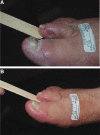Debridement of Diabetic Foot Ulcers
- PMID: 34376065
- PMCID: PMC9527061
- DOI: 10.1089/wound.2021.0016
Debridement of Diabetic Foot Ulcers
Abstract
Diabetic foot ulcerations have devastating complications, including amputations, poor quality of life, and life-threatening infections. Diabetic wounds can be protracted, take significant time to heal, and can recur after healing. They are costly consuming health care resources. These consequences have serious public health and clinical implications. Debridement is often used as a standard of care. Debridement consists of both nonmechanical (autolytic, enzymatic) and mechanical methods (sharp/surgical, wet to dry debridement, aqueous high-pressure lavage, ultrasound, and biosurgery/maggot debridement therapy). It is used to remove nonviable tissue, to facilitate wound healing, and help prevent these serious outcomes. What are the various forms and rationale behind debridement? This article comprehensively reviews cutting-edge methods and the science behind debridement and diabetic foot ulcers.
Keywords: debridement; diabetes; dressings; foot ulcers; public health.
Conflict of interest statement
No competing financial interests exist. No ghostwriters or editorial service was used for any portion of this article.
Figures




References
-
- International Working Group on the Diabetic Foot. IWGDF Guidelines on the prevention and management of diabetic foot disease. Maastricht, The Netherlands: International Working Group on the Diabetic Foot, 2019.
-
- Sumpio BE. Foot ulcers. N Engl J Med 2000;343:787–793. - PubMed
-
- Sheffield PJ, Fife CE, Smith AP. Wound Care Practice. Flagstaff, AZ: Best Publising Company, 2004.
-
- Margolis DJ, Allen-Taylor L, Hoffstad O, Berlin JA. Diabetic neuropathic foot ulcers: the association of wound size, wound duration, and wound grade on healing. Diabetes Care 2002;25:1835–1839. - PubMed
-
- Diabetes.org.uk. Diabetes Reports and Statistics 2019. Diabetes.org.uk, 2019.
Publication types
MeSH terms
LinkOut - more resources
Full Text Sources
Medical
